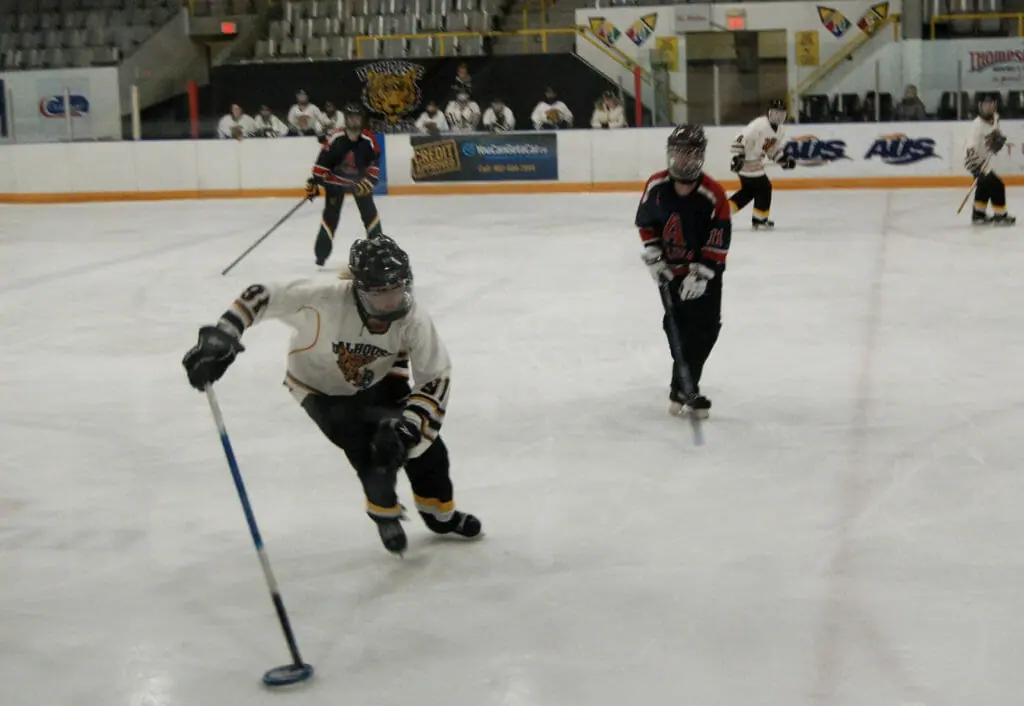It’s still dark outside when the Dalhousie University Tigers ringette team hits the ice on Friday at 6:30 a.m. At the end of another long school week, players are still excited to be at the rink.
“I love that time. Any other time during the day would probably not work for me,” says Maia Kvas, a fourth-year defender and president of the club executive.
Ringette is a sport played on ice with straight sticks and a large rubber ring. Like hockey, there are five players and a goalie per side, but the games have very different rules. For example, in ringette, the ring must be passed over every blue line, and a team has 30 seconds to take a shot on net after they gain possession.
Dalhousie’s competitive ringette team is training for the University Challenge Cup (UCC) in December, hosted by Wilfred Laurier University. The Tigers made their roster in October, giving them two and a half months to prepare. This is shorter than most ringette seasons, where teams usually have eight months before playoffs in the spring. The Tigers have a Nova Scotia University Challenge Cup in second semester, but their main focus is on the UCC in December.
Time commitment is different, too. In addition to Friday morning practices, the 15-person team has two off-ice dry land sessions every week, as well as an ice time on Sunday evenings that is open to anyone who signed up for the ringette club, usually around 25 players.
“It’s kind of a weird dynamic because we’re a competitive team with a lot of girls who have played elite level ringette for a long time, but the commitment is a lot different than when we were [younger],” says Shane Galley, a second-year centre and vice president of the club executive. “You don’t practice as much, but [the UCC] is a way harder tournament.”
At the UCC, teams from across Canada compete over an intense four days between Christmas and New Year’s.
“You give up a lot of your holiday break, but it’s totally worth it,” says Galley, as she’s made great memories with her teammates there.
“Friendships with girls you play a sport with are so different than [other] friendships because when you get that win or even when you experience those losses, it’s such a different kind of bonding.”
Different experiences
To prepare for UCCs, the Tigers have games organized by Ringette Nova Scotia. There aren’t enough Maritime university teams to make an actual league, so the Tigers play stand-alone games against Acadia University and Saint Mary’s University, as well as U19 AA teams and Nova Scotia’s 18+ team.
Although not playing against more university teams is a disadvantage, Kvas says it’s interesting to play different styles of ringette and face new challenges. The 18+ team has a lot of experience and plays a very smart game, whereas the U19 AA teams, being younger, have a lot of energy.
Within Dalhousie’s team, there are many styles of play because players of different ages come from Alberta, Ontario, Quebec, Nova Scotia and New Brunswick. Each province has different strengths; some are more aggressive, while others focus a lot on passing. Kvas says that Alberta, for example, produces really good skaters.
“It’s nice to have a diverse background of girls on the team because they can bring in new drills and new plays, so we’re learning — I know I’m learning a lot,” she says.
In Kvas’ first year at Dalhousie, all 10 or so players who tried out made the team. At the UCCs, they had two-thirds the bench of other teams and were exhausted every game.
The program has since grown, and more people trying out has made the team more competitive. Last year, they lost some close games and then won the tier 2 final at the UCC, coming seventh out of 14 teams. With a lot of returning players this year, they are improving quickly, says Galley.
Ringette rising across the country
Before coming to Dal, Kvas played Timmins A in Ontario, while Galley played for Lac St Louis AA in Quebec. They both say university ringette wasn’t a well-known option when they were growing up.
“A lot of girls […] thought that they had to switch to hockey because ‘ringette never brings you anywhere,’” Kvas says, but her experience that shown that “there is still a lot of potential to play high quality ringette after high school.”
In her second year, Kvas’ old coach asked her to send a video saying that she plays for Dalhousie. He did the same with Timmins athletes who now play for Guelph University, Western University, Carleton University and University of Ottawa, so that they can inspire younger ringette players to stick with the game.
Scholarships for university ringette are starting to became a reality as well. The University of Alberta, for example, offers $45,000 to its players each year.
“It feels awesome to be a part of” the growth of the sport, says Galley.



Recent Comments